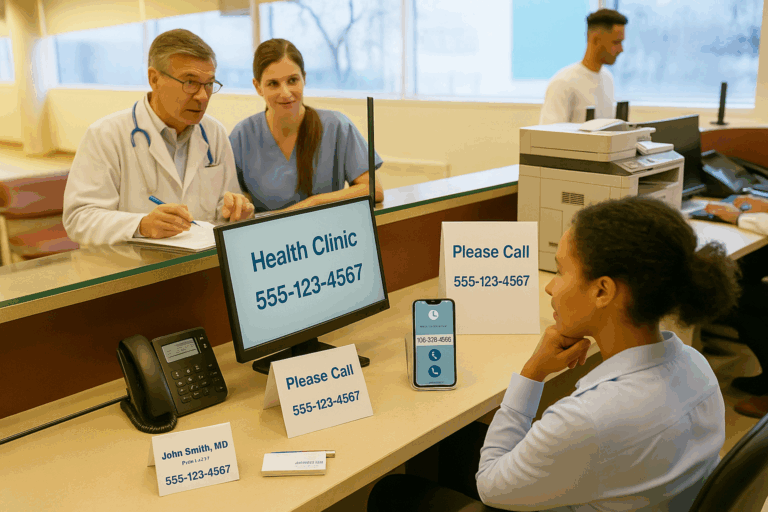Let’s take a moment to think about something a bit less medically and HIPAA-compliance oriented, but still important to your patients’ perception of your practice. I’m talking about the time that people spend on hold, and what they hear while in that all-too-familiar space between wanting to speak to a human being and actually getting to do so.
Being on hold is something we’ve all experienced, and it’s typically considered a necessary evil, something we just need to put up with. It’s also true that some time spent on hold is maddening, while others are more pleasant (or at least less frustrating.) Gaining a little insight into the science and psychology of being on hold, as well as looking back at your own encounters with being on hold, can be helpful as you decide how your practice will manage its music selection.
The History and Psychology of Hold Music
According to experts in hold music – yes, there are people who study the subject and who are considered experts – the whole point of hold music is to keep people from hanging up. Hold music has been with us since the early 1960s, when switchboard operators first started asking people to “hold” as they connected calls. The remarkable origin of using music during that period traces back to factory owner Alfred Levy, who became frustrated that the broadcast from the radio station next door to his facility was being picked up on his company’s phone system and transmitted to his callers. The intrusion turned out to be caused by an exposed wire touching a metal girder, but Levy quickly recognized that what had seemed to be a problem was actually an opportunity: in 1966 he filed for and was granted a patent for Music On Hold. His application’s description of the frustration of being on hold is worth noting: “Listening to a completely unresponsive instrument is tedious. and calls often are abandoned altogether or remade, which leads to annoyance and a waste of time and money.” For medical practices, it’s clear that being on hold is a part of the patient experience that can make a real difference.
Back to the experts on hold music. According to David Green, Board Chair of the Experience Marketing Association (formerly known as the On Hold Messaging Association), their years of study have found what many of us know intuitively:
- Loops of the same music, repeating over and over again, make listeners count intervals, and lead to aggravation as the number of loops increases.
- Jingles and advertising messages can be irritating, especially if they are repeated.
- Music selections need to be appropriate to the business: pop music would be a poor choice for a funeral home.
- Simple is often better. There’s a reason why elevator music has never really changed.
Perhaps what’s most important is that not being able to speak to a human ranks as the second greatest annoyance for Americans (according to a survey conducted by Consumer Reports.) That’s why a communication system like RingRx — which offers flexible call routing and easy voicemail access — is such a smart investment. A phone system that puts patients first through features like Virtual Receptionist, Call Routing, Parking Lot, and Ring Groups makes sure that calls are never missed and routed efficiently, making it easy for patients and other providers to reach the right people as quickly as possible. Adding an enjoyable musical choice – or helpful tips about vaccinations, annual check-ups, or the hours you’re open on weekends or evenings – turns a negative into a positive.
Music On Hold Options to Suit Your Preference
When your patients call your office, being put on hold is clearly not the goal, so whatever they hear will already have a strike against it. No matter how much music triggers dopamine and serotonin, those happy hormones are no match for getting the appointment, prescription renewal, or answer that they’re looking for. Still, it’s far better than silence. What they hear is as important as is minimizing the amount of time that they spend listening to it. When making your selection, you want to consider your patient demographic, and you don’t want to lose the sense of being professional. Classical is always safe, if a little boring to some. Smooth jazz is rarely objectionable, and has a bit of a cool factor. Rock may seem like a fun choice, but is probably a bit too edgy if you have older patients – or if you’re a pediatrics office, for that matter.
Music on Hold is the default setting for all RingRx accounts, and there are five different options available for you to choose from based on your (or your patients’) preferences. You can switch from one option to the other over the course of days or weeks to see which music your patients respond to best, or you can choose to customize your own music, and even add informational messages appropriate to your practice.
One word of caution about making a personalized playlist: it may be the most fun (if most time-consuming) option, but doing so may put you in jeopardy of unconsciously and unintentionally breaking the law. Using music that you haven’t paid a licensing fee for represents copyright infringement, and the fines for doing so can be hefty. You can choose to pay the license fees, which are generally reasonable and which are determined by the number of lines you have connected to your business, or you can search the internet for royalty free Music on Hold. It’s undoubtedly simpler to choose one of RingRx’s five options, which will keep you in compliance with copyright laws.
Whichever option you choose, making a thoughtful selection that offers your callers a pleasant experience is well worth the time. It can make a significant difference in the way your patients feel while they’re waiting for you to respond to their call, and how they engage with your staff once they’ve been connected.
For more information on RingRx’s Music on Hold, take a look at our guide here. And for more information on how our other features can improve your office’s efficiency and improve your patients’ experience, contact us today.




